This set of Data Structures & Algorithms Multiple Choice Questions & Answers (MCQs) focuses on “Binary Tree Operations”.
1. What is the maximum number of children that a binary tree node can have?
a) 0
b) 1
c) 2
d) 3
View Answer
Explanation: In a binary tree, a node can have atmost 2 nodes (i.e.) 0,1 or 2 left and right child.
2. The following given tree is an example for?
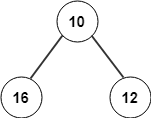
a) Binary tree
b) Binary search tree
c) Fibonacci tree
d) AVL tree
View Answer
Explanation: The given tree is an example for binary tree since has got two children and the left and right children do not satisfy binary search tree’s property, Fibonacci and AVL tree.
3. A binary tree is a rooted tree but not an ordered tree.
a) true
b) false
View Answer
Explanation: A binary tree is a rooted tree and also an ordered tree (i.e) every node in a binary tree has at most two children.
4. How many common operations are performed in a binary tree?
a) 1
b) 2
c) 3
d) 4
View Answer
Explanation: Three common operations are performed in a binary tree- they are insertion, deletion and traversal.
5. What is the traversal strategy used in the binary tree?
a) depth-first traversal
b) breadth-first traversal
c) random traversal
d) Priority traversal
View Answer
Explanation: Breadth first traversal, also known as level order traversal is the traversal strategy used in a binary tree. It involves visiting all the nodes at a given level.
6. How many types of insertion are performed in a binary tree?
a) 1
b) 2
c) 3
d) 4
View Answer
Explanation: Two kinds of insertion operation is performed in a binary tree- inserting a leaf node and inserting an internal node.
7. What operation does the following diagram depict?
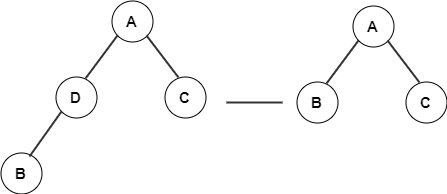
a) inserting a leaf node
b) inserting an internal node
c) deleting a node with 0 or 1 child
d) deleting a node with 2 children
View Answer
Explanation: The above diagram is a depiction of deleting a node with 0 or 1 child since the node D which has 1 child is deleted.
8. General ordered tree can be encoded into binary trees.
a) true
b) false
View Answer
Explanation: General ordered tree can be mapped into binary tree by representing them in a left-child-right-sibling way.
9. How many bits would a succinct binary tree occupy?
a) n+O(n)
b) 2n+O(n)
c) n/2
d) n
View Answer
Explanation: A succinct binary tree occupies close to minimum possible space established by lower bounds. A succinct binary tree would occupy 2n+O(n) bits.
10. The average depth of a binary tree is given as?
a) O(N)
b) O(√N)
c) O(N2)
d) O(log N)
View Answer
Explanation: The average depth of a binary tree is given as O(√N). In case of a binary search tree, it is O(log N).
11. How many orders of traversal are applicable to a binary tree (In General)?
a) 1
b) 4
c) 2
d) 3
View Answer
Explanation: The three orders of traversal that can be applied to a binary tree are in-order, pre-order and post order traversal.
12. If binary trees are represented in arrays, what formula can be used to locate a left child, if the node has an index i?
a) 2i+1
b) 2i+2
c) 2i
d) 4i
View Answer
Explanation: If binary trees are represented in arrays, left children are located at indices 2i+1 and right children at 2i+2.
13. Using what formula can a parent node be located in an array?
a) (i+1)/2
b) (i-1)/2
c) i/2
d) 2i/2
View Answer
Explanation: If a binary tree is represented in an array, parent nodes are found at indices (i-1)/2.
14. Which of the following properties are obeyed by all three tree – traversals?
a) Left subtrees are visited before right subtrees
b) Right subtrees are visited before left subtrees
c) Root node is visited before left subtree
d) Root node is visited before right subtree
View Answer
Explanation: In preorder, inorder and postorder traversal the left subtrees are visited before the right subtrees. In Inorder traversal, the Left subtree is visited first then the Root node then the Right subtree. In postorder traversal, the Left subtree is visited first, then Right subtree and then the Root node is visited.
15. Construct a binary tree using the following data.
The preorder traversal of a binary tree is 1, 2, 5, 3, 4. The inorder traversal of the same binary tree is 2, 5, 1, 4, 3.
a) 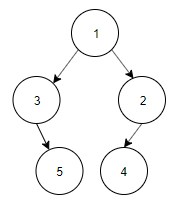
b) 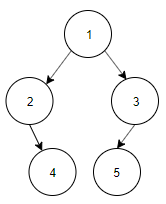
c) 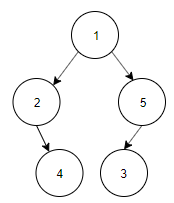
d) 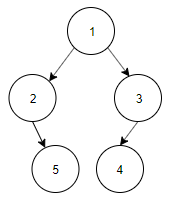
View Answer
Explanation: Here,
Preorder Traversal is 1, 2, 5, 3, 4
Inorder Traversal is 2, 5, 1, 4, 3
Root node of binary tree is the first node in Preorder traversal.
The rough sketch of tree is:
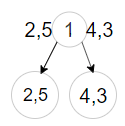
Second node in preorder traversal is 2. This makes 5 as right child to node 2. The fourth node in preorder traversal is 3. This makes 4 as right child to node 3. Thus the final tree is:

Sanfoundry Global Education & Learning Series – Data Structure.
To practice all areas of Data Structure, here is complete set of 1000+ Multiple Choice Questions and Answers.
If you find a mistake in question / option / answer, kindly take a screenshot and email to [email protected]
- Check Programming Books
- Check Computer Science Books
- Check Data Structure Books
- Practice Design & Analysis of Algorithms MCQ
- Practice Programming MCQs
